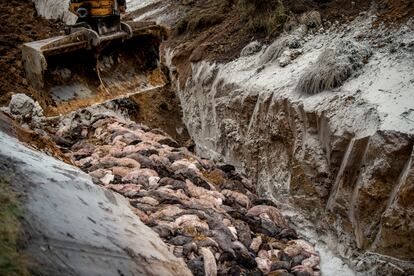Denmark’s Social Democrats win election despite controversy over massive mink cull
The early vote was called after a report criticized Mette Frederiksen’s November 2020 order to kill 17 million animals out of fear they could spread the coronavirus


Danish Prime Minister Mette Frederiksen’s Social Democrats comfortably won Tuesday’s parliamentary election with around 28% of the vote, the party’s best results in over 20 years. Her wider “red” center-left coalition collectively won 87 seats in mainland Denmark, one seat in the Faroe Islands and is expected to take two more in Greenland, which would give the bloc the 90 seats required for a majority in the 179-seat parliament, the Folketing. Despite her victory, Frederiksen has signaled that she will resign and attempt to build a broader governing coalition.
Frederiksen, 44, was forced to call an early election in October over a report that came out in the summer criticizing her November 2020 decision to cull millions of mink as a precautionary measure against the spread of a mutation of the coronavirus. The order was later found to have been given without the proper legal framework to back it up, and it resulted in ruin for many mink farms in a country that was the world’s largest exporter of their fur.
At the time of the decision, the pandemic was causing thousands of daily deaths in Europe. The Danish body that monitors infectious diseases warned that virus mutations had been detected in several mink farms, and that, in the worst-case scenario, Denmark could “become the new Wuhan.” The next day, Frederiksen that all 17 million mink would be slaughtered. “She acted authoritatively. There was no legal basis for making that decision,” said Frederik Waage, a judge at the Eastern High Court, in recent statements to EL PAíS in Copenhagen. “The legislation necessary to be able to carry out this massive sacrifice was approved in parliament several days after the operation had begun.”
Martin Merrild, until recently director of the Danish Food and Agriculture Association, watched thousands of mink get slaughtered at his farm in the municipality of Sture, in the northwest of the Jutland peninsula. “The vets had assured me that in a few days all the infected animals would have recovered. In addition, it was less than a week before the skinning season was due to beging and most of them were going to be slaughtered anyway,” he said by phone. “And on hundreds of farms across the country, there wasn’t a single mink that was infected.”
Denmark was not the only EU member to order a mink cull during the pandemic. In Spain, more than 100,000 were slaughtered, and in the Netherlands, more than a million. But only Denmark gave instructions that not one should be left alive (save for Ireland, where there were only three farms, and plans to dismantle them even before the pandemic). Merrild recalled begging the prime minister to meet with university professors and veterinary experts to try to find an alternative. Morgens Jensen, the Minister for Food, Agriculture and Fisheries, resigned a few days later, considering that he no longer had “the confidence of the parliamentary majority.”
The manner in which the mass cull was carried out also received much criticism. In some areas of the country, the bodies were not buried deep enough and some of them resurfaced. In other areas, decomposing mink began to contaminate nearby waters and hundreds of thousands had to be exhumed.

The Social Democratic government reached a deal with the more than 3,000 affected mink farmers to compensate the sector with 19 billion Danish crowns ($2.5 billion). The opposition has since portrayed Frederiksen as a “power-thirsty” politician whose illegal decision destroyed a priority industry for the country and came at an astronomical cost for the public coffers. Kopenhagen Fur, the world’s largest mink fur auction house, has announced that it will close next year. China was by far the main customer of this Danish industry.
Early election
In April 2021, the Folketing approved the creation of a commission to investigate the government’s actions during the mink crisis. The report was published in June, and said that some of Frederiksen’s statements were “grossly misleading” and that “illegal instructions were given to the authorities.” The prime minister received an official reprimand, after attempts by the opposition to promote an impeachment failed. Even so, the Social Liberal Party, a traditional ally of the Social Democrats, subsequently demanded early elections if Frederiksen did not want to be subjected to a vote of no confidence.
In late September the executive announced that the ban on farming mink will expire on January 1. But not everyone believes it is possible to go back to business as usual. “The fur industry is dead in Denmark. It will never come back to life,” said Merrild.
Yet others would like to keep things the way they are now. Britta Riis, director of the Danish organization Dyrenes Beskyttelse (Animal Protection), considers it a serious mistake to restart mink farm activity in the country. “The existence of mink farms implies that there will necessarily be cruelty against animals, and they are a danger to the environment and to public health,” she said in an email interview. “Danish taxpayers have already had to pay a lot of money to close these farms, and keeping the ban would be good for society as a whole.”
Tu suscripción se está usando en otro dispositivo
¿Quieres añadir otro usuario a tu suscripción?
Si continúas leyendo en este dispositivo, no se podrá leer en el otro.
FlechaTu suscripción se está usando en otro dispositivo y solo puedes acceder a EL PAÍS desde un dispositivo a la vez.
Si quieres compartir tu cuenta, cambia tu suscripción a la modalidad Premium, así podrás añadir otro usuario. Cada uno accederá con su propia cuenta de email, lo que os permitirá personalizar vuestra experiencia en EL PAÍS.
¿Tienes una suscripción de empresa? Accede aquí para contratar más cuentas.
En el caso de no saber quién está usando tu cuenta, te recomendamos cambiar tu contraseña aquí.
Si decides continuar compartiendo tu cuenta, este mensaje se mostrará en tu dispositivo y en el de la otra persona que está usando tu cuenta de forma indefinida, afectando a tu experiencia de lectura. Puedes consultar aquí los términos y condiciones de la suscripción digital.
More information
Últimas noticias
Most viewed
- Reinhard Genzel, Nobel laureate in physics: ‘One-minute videos will never give you the truth’
- Oona Chaplin: ‘I told James Cameron that I was living in a treehouse and starting a permaculture project with a friend’
- Pablo Escobar’s hippos: A serious environmental problem, 40 years on
- Why we lost the habit of sleeping in two segments and how that changed our sense of time
- Charles Dubouloz, mountaineering star, retires at 36 with a farewell tour inspired by Walter Bonatti










































